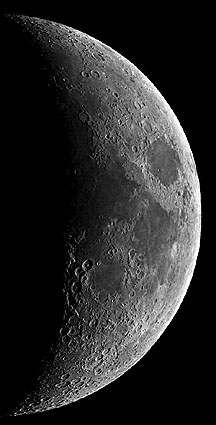April 25, 2015
The Star of Astronomy Night
Originally published April 24, 2004
Image Credit: Craig Zerbe |
|
The Star of Astronomy Night Today is Astronomy Day, and the star of the night sky is five days old, awaiting your visit with friends to be introduced to its charms. The Moon is often the first heavenly body people look at when they become attracted to the sky - and why not? The Moon is big and easy to find. It becomes more fascinating as the observer migrates from eyes to binoculars to telescope, and as she learns more about it. Tonight's Moon, in the western sky after sunset, should look similar to this five day view taken by Craig Zerbe on April 9, 2000. Mare Crisium is centered, and the Nectaris basin with high Altai Scarp rim is on the terminator. When you show the Moon to friends tonight point out the spectacular craters Theophilus, Cyrillus and Catharina, and the well-placed pair Atlas and Hercules. And also check to see if the Cauchy rille, fault and domes are visible, and look for the large curved rilles in Janssen. And pity the poor bloke trying to excite visitors with a look at a faint fuzzy! Technical Details: Celestron 11 inch SCT mounted on a Losamady G11, using an Astrovid 2000 camera. The image is a mosaic of 10 images taken at f6.3 and processed using an unsharp mask and a high pass kernel filter. Related Links: Yesterday's LPOD: Magnetic Moon Tomorrow's LPOD: Ortho Atlas |
Author & Editor:
Charles A. Wood
COMMENTS?
Register, Log in, and join in the comments.




